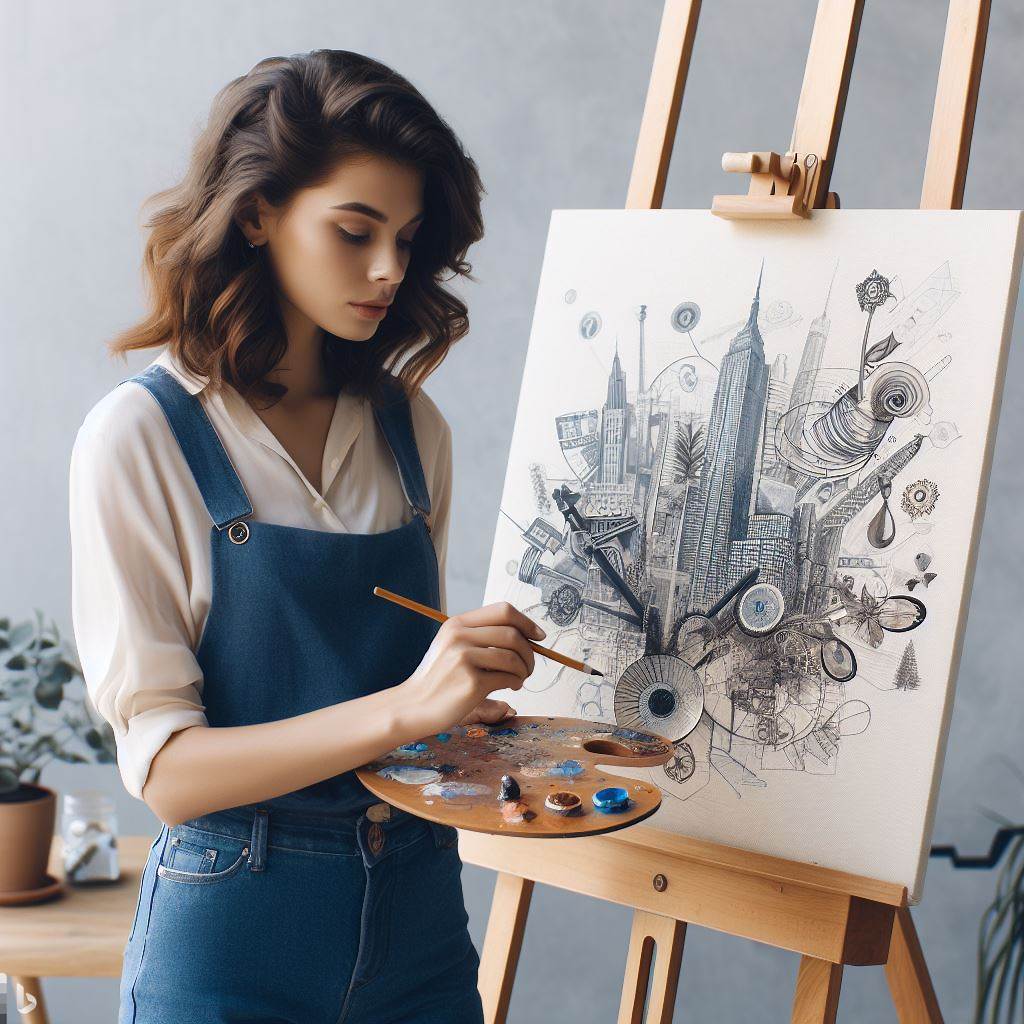Income Realities: What US Artists Really Earn Today
Last Updated on November 12, 2023
Introduction
In today’s dynamic arts landscape, understanding the true earnings of US artists is crucial. Delving into income realities unveils the challenges creatives face.
This blog post aims to dissect the financial intricacies, spotlighting the often-overlooked struggles artists endure.
By grasping the nuances of their earnings, we gain insight into systemic issues impacting the artistic community.
This exploration seeks not only to inform but also to spark conversations about the need for equitable compensation.
Through a concise examination, we unravel the complexities shaping the financial fabric of American artists’ lives.
Join us on this exploration, as we unveil the stark realities that underscore the artistic pursuits many hold dear. In a society that often glamorizes the arts, it’s time to confront the financial disparities head-on.
Factors Influencing Artist Income
Factors that Affect Earning Potential
- Level of experience and expertise.
- Type of art medium (performing arts, visual arts, etc.).
- Location and market demand.
- Opportunities for grants and sponsorships.
Artists’ earning potentials are influenced by various factors that shape their income realities. Understanding these factors is essential in comprehending the income disparities among artists.
Contribution of Factors to Income Disparities
1. Level of experience and expertise
An artist’s level of experience and expertise significantly impacts their earning potential.
Artists who have honed their skills and have a significant portfolio are likely to command higher fees and secure better-paying opportunities.
2. Type of art medium
The type of art medium an artist specializes in also affects their income. Performing artists may have access to higher-paying gigs and contracts, while visual artists may sell original artwork at varying price points.
This disparity in income opportunities exists due to the nature of demand and market dynamics for different art forms.
3. Location and market demand
The geographical location where artists operate plays a crucial role in their earning potential.
Artists based in major cities or cultural hubs often have greater access to a larger customer base and a higher demand for their work.
This increased demand translates into increased opportunities and higher income potential.
4. Opportunities for grants and sponsorships
The availability and accessibility of grants and sponsorships can substantially impact an artist’s income.
Artists who are able to secure grants or secure sponsors for their projects often have additional financial support.
This not only allows them to focus on their creative pursuits but also boosts their income by covering various expenses.
Artists with limited experience, those specializing in less commercially popular art mediums, or operating in locations with lower demand may struggle to secure high-paying opportunities and may rely more on personal sales or smaller commissions.
These income disparities are not solely a reflection of artistic talent but result from complex economic and market conditions.
It is crucial to recognize the influence of these factors and work towards creating a more equitable environment where artists can thrive and earn a sustainable income.
Supporting artists through funding programs, art education, mentorship, and increased exposure can help create a fairer landscape for all artists to earn a living from their craft.
Read: The Evolution of the Artist Career in the USA: A Timeline
Statistics on Artist Income
Recent studies and surveys have shed light on the earnings of artists in the United States. The statistics reveal both the average and median income levels for artists in the country.
Comparisons with other professions can highlight the disparities in artist income.
Overview of Recent Studies or Surveys on Artist Earnings in the US
Artists’ income in the United States has been the subject of various studies and surveys in recent years.
These research efforts aim to understand the financial realities faced by artists and provide insights into their economic well-being.
One notable study conducted by the National Endowment for the Arts (NEA) titled “Equal Opportunity Data Mining: National Statistics about Working Artists” sheds light on the income gaps and disparities among artists and the general workforce.
The study examines the earnings of artists across different disciplines and provides a comprehensive overview of their financial situations.
Another survey conducted by the Bureau of Labor Statistics (BLS) collects data on various occupations, including artists.
The survey measures the average and median income of artists in the United States and helps paint a clearer picture of their earning potential.
Relevant Statistics on Average and Median Income for Artists
The statistics on the average and median income for artists in the United States vary depending on the discipline and level of experience.
However, these figures provide valuable insights into the earnings of artists and the financial challenges they face.
According to the NEA study, the average income of artists in the US is around $43,000 per year. However, this figure masks significant disparities among different artistic disciplines.
For example, dancers and choreographers have an average income of $33,000, while musicians and singers earn an average of $42,000 per year.
The median income for artists paints a more realistic picture of their earnings. The BLS survey reveals that the median income for artists in the US is around $48,000 per year.
This means that half of all artists earn less than this amount, further highlighting the financial challenges they face.
Comparing Artist Income to Other Professions to Showcase the Disparities
When comparing artist income to other professions, significant disparities become evident. Many artists, despite their talent and dedication, struggle to earn a living wage while pursuing their passion.
Comparisons with more financially rewarding occupations highlight these discrepancies.
According to the BLS, the median income for all occupations in the US is approximately $53,000 per year.
This means that artists earn less than the average worker in other fields, further emphasizing the financial difficulties they often encounter.
Moreover, artists face additional challenges such as job insecurity and lack of benefits, making it even more challenging for them to establish stable financial foundations.
In general, recent studies and surveys shed light on the income realities of artists in the United States.
The statistics reveal both the average and median income levels for artists, along with the disparities compared to other professions.
These findings underscore the need for greater support and recognition of artists’ contributions to society and their economic well-being.
Read: Mastering Niche Markets: Pet, Food, & Drone Photography in the US
Challenges Faced by US Artists
Common difficulties artists encounter regarding income stability
1. Irregular income and freelance nature of artistic work
Artists often face the challenge of an unpredictable income due to the nature of their freelance work.
They may experience periods of high demand and financial stability, followed by droughts where they struggle to secure paid projects.
2. Lack of access to affordable healthcare and retirement benefits
Unlike traditional employment, artists often lack access to employer-sponsored healthcare and retirement benefits.
This leaves them vulnerable and responsible for finding their own insurance plans and planning for their retirement, which can be financially burdensome.
3. Limited financial resources for production and marketing
Artists frequently struggle to obtain the necessary funds for production and marketing expenses. Art supplies, studio space, equipment, and promotion all require financial investment.
Without adequate resources, artists may find it challenging to produce and promote their work effectively.
The impact of these challenges on the overall well-being of artists
The challenges mentioned above have a profound impact on the well-being of artists, affecting not only their financial stability but also their mental and physical health.
1. Financial stress and insecurity
The irregular income and lack of access to employee benefits lead to financial stress and insecurity.
Artists often live paycheck to paycheck and face difficulties in meeting their basic needs, such as paying rent and buying groceries.
This constant financial pressure can contribute to anxiety and overall well-being decline.
2. Limited access to quality healthcare
The absence of affordable healthcare options forces artists to prioritize their expenses, often putting off necessary medical treatments or check-ups.
This can lead to untreated health issues, chronic conditions, and ultimately, a decline in their overall well-being.
3. Lack of retirement planning
Without employer-sponsored retirement plans, artists struggle to save for their future.
This absence of long-term financial planning can cause additional stress and anxiety as artists worry about their financial security in their later years.
4. Impacted artistic growth and creativity
The lack of financial resources for production and marketing hampers artists’ ability to fully explore their artistic potential and reach a wider audience.
This limitation can dampen their motivation, hinder their creative development, and negatively impact their overall well-being.
5. Difficulty maintaining work-life balance
The irregular income and constant hustle for projects can make it challenging for artists to establish a healthy work-life balance.
Long hours and personal sacrifices may be necessary to sustain their artistic careers, leading to increased stress and potential burnout.
In essence, US artists face significant challenges in maintaining income stability.
The irregular nature of their work, coupled with limited access to affordable healthcare, retirement benefits, and financial resources for production and marketing, greatly impacts their overall well-being.
It is vital to recognize and address these challenges to support and sustain the artistic community in the United States.
Read: Photography Workshops & Events to Attend in the USA in 2024

Strategies for Improving Artist Income
Explore various approaches and tactics artists can adopt to enhance their earnings
- Diversifying income streams (teaching, commissions, grants)
- Building and nurturing a strong network of supporters
- Leveraging technology and social media for self-promotion
Provide real-life examples of artists who have successfully increased their income using these strategies
Artists are often faced with the challenge of earning a sustainable income from their creative work. However, by exploring various approaches and adopting specific tactics, artists can significantly enhance their earnings.
1. Diversifying Income Streams
One effective strategy for improving artist income is diversifying income streams.
Instead of relying solely on sales from their artwork, artists can explore other avenues such as teaching, securing commissions, or applying for grants.
By expanding their revenue sources, artists can increase their financial stability. For example, a painter might offer private art classes or workshops to interested individuals or schools.
This not only provides an additional income stream but also allows artists to share their knowledge and passion with others, creating a fulfilling and financially rewarding experience.
2. Building and Nurturing a Strong Network of Supporters
Another important strategy is building and nurturing a strong network of supporters.
By cultivating relationships with art collectors, galleries, and other artists, artists can create opportunities for collaboration, exhibitions, and sales.
Through networking events, online communities, and art conferences, artists can connect with potential buyers and form long-lasting relationships.
This network of supporters can introduce artists to new opportunities, increase exposure for their work, and ultimately lead to higher income levels.
3. Leveraging Technology and Social Media for Self-Promotion
In today’s digital age, leveraging technology and social media is crucial for self-promotion.
Artists can use platforms like Instagram, Facebook, and Twitter to showcase their work, engage with a wider audience, and attract potential buyers.
By sharing behind-the-scenes glimpses into their creative process, artists can develop a personal connection with their audience, which can translate into increased sales.
Additionally, artists can explore e-commerce platforms or create their own websites to sell their artwork directly to collectors, eliminating the need for gallery commissions.
Real-Life Examples
There are numerous artists who have successfully implemented these strategies to improve their income.
One notable example is Jane, a mixed media artist who diversified her income streams by offering art classes, securing commissioned projects, and applying for grants.
By doing so, Jane not only increased her earnings but also gained recognition in the art community.
Another example is Mark, a photographer who built a strong network of supporters by actively participating in art conferences and collaborating with influential artists.
Through these connections, Mark’s work was exhibited in prestigious galleries, leading to higher sales and increased income.
Lastly, Sarah, a painter, leveraged technology and social media to promote her work.
By consistently sharing her art on Instagram, Sarah gained a significant following and received direct inquiries from interested buyers.
This increased visibility and direct sales helped Sarah significantly boost her income.
Generally, improving artist income involves exploring different approaches and tactics.
Diversifying income streams, building a network of supporters, and leveraging technology and social media are all viable strategies that can lead to financial success for artists.
By learning from real-life examples like Jane, Mark, and Sarah, artists can find inspiration and guidance to enhance their own earning potential.
Read: The Balance of Art & Business in US Photography Industry
Support and Resources for US Artists
Share information about existing support systems and resources available to artists:
- Government grants and funding programs.
- Non-profit organizations that offer financial assistance and guidance.
- Professional associations and networks that provide mentorship and opportunities.
Encourage artists to utilize these support systems and take advantage of available resources.
Conclusion
Recap the main points discussed in the blog post
Throughout this blog post, we have examined the income realities faced by artists in the United States today. We have delved into the challenges they encounter and the financial struggles they often endure.
Emphasize the significance of understanding the income realities for US artists
Understanding the income realities for US artists is crucial for bringing awareness to the lack of financial stability they face.
This knowledge allows us to appreciate the value of their work and the contributions they make to society.
Provide a call to action for readers to support and appreciate the work of artists
In order to make a difference, we must actively support and appreciate the work of artists. By buying artwork, attending concerts, and spreading awareness, we can show our appreciation and help artists thrive.
So, let us stand together and recognize the importance of artists’ contributions. Let us support and champion their work, ensuring that their income realities improve and they receive the recognition they deserve.


